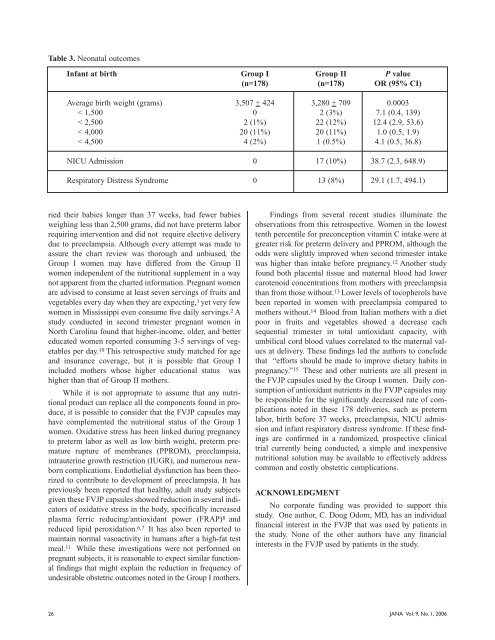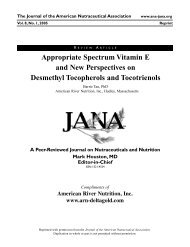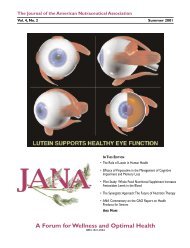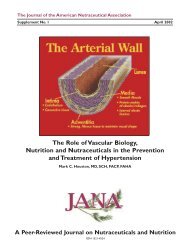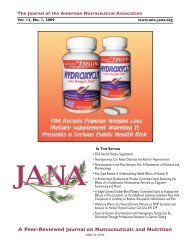JANA Vol 9 #1 - American Nutraceutical Association
JANA Vol 9 #1 - American Nutraceutical Association
JANA Vol 9 #1 - American Nutraceutical Association
Create successful ePaper yourself
Turn your PDF publications into a flip-book with our unique Google optimized e-Paper software.
Table 3. Neonatal outcomes<br />
ried their babies longer than 37 weeks, had fewer babies<br />
weighing less than 2,500 grams, did not have preterm labor<br />
requiring intervention and did not require elective delivery<br />
due to preeclampsia. Although every attempt was made to<br />
assure the chart review was thorough and unbiased, the<br />
Group I women may have differed from the Group II<br />
women independent of the nutritional supplement in a way<br />
not apparent from the charted information. Pregnant women<br />
are advised to consume at least seven servings of fruits and<br />
vegetables every day when they are expecting, 1 yet very few<br />
women in Mississippi even consume five daily servings. 2 A<br />
study conducted in second trimester pregnant women in<br />
North Carolina found that higher-income, older, and better<br />
educated women reported consuming 3-5 servings of vegetables<br />
per day. 10 This retrospective study matched for age<br />
and insurance coverage, but it is possible that Group I<br />
included mothers whose higher educational status was<br />
higher than that of Group II mothers.<br />
While it is not appropriate to assume that any nutritional<br />
product can replace all the components found in produce,<br />
it is possible to consider that the FVJP capsules may<br />
have complemented the nutritional status of the Group I<br />
women. Oxidative stress has been linked during pregnancy<br />
to preterm labor as well as low birth weight, preterm premature<br />
rupture of membranes (PPROM), preeclampsia,<br />
intrauterine growth restriction (IUGR), and numerous newborn<br />
complications. Endothelial dysfunction has been theorized<br />
to contribute to development of preeclampsia. It has<br />
previously been reported that healthy, adult study subjects<br />
given these FVJP capsules showed reduction in several indicators<br />
of oxidative stress in the body, specifically increased<br />
plasma ferric reducing/antioxidant power (FRAP) 8 and<br />
reduced lipid peroxidation. 6,7 It has also been reported to<br />
maintain normal vasoactivity in humans after a high-fat test<br />
meal. 11 While these investigations were not performed on<br />
pregnant subjects, it is reasonable to expect similar functional<br />
findings that might explain the reduction in frequency of<br />
undesirable obstetric outcomes noted in the Group I mothers.<br />
26<br />
Infant at birth Group I Group II P value<br />
(n=178) (n=178) OR (95% CI)<br />
Average birth weight (grams) 3,507 + 424 3,280 + 709 0.0003<br />
< 1,500 0 2 (3%) 7.1 (0.4, 139)<br />
< 2,500 2 (1%) 22 (12%) 12.4 (2.9, 53.6)<br />
< 4,000 20 (11%) 20 (11%) 1.0 (0.5, 1.9)<br />
< 4,500 4 (2%) 1 (0.5%) 4.1 (0.5, 36.8)<br />
NICU Admission 0 17 (10%) 38.7 (2.3, 648.9)<br />
Respiratory Distress Syndrome 0 13 (8%) 29.1 (1.7, 494.1)<br />
Findings from several recent studies illuminate the<br />
observations from this retrospective. Women in the lowest<br />
tenth percentile for preconception vitamin C intake were at<br />
greater risk for preterm delivery and PPROM, although the<br />
odds were slightly improved when second trimester intake<br />
was higher than intake before pregnancy. 12 Another study<br />
found both placental tissue and maternal blood had lower<br />
carotenoid concentrations from mothers with preeclampsia<br />
than from those without. 13 Lower levels of tocopherols have<br />
been reported in women with preeclampsia compared to<br />
mothers without. 14 Blood from Italian mothers with a diet<br />
poor in fruits and vegetables showed a decrease each<br />
sequential trimester in total antioxidant capacity, with<br />
umbilical cord blood values correlated to the maternal values<br />
at delivery. These findings led the authors to conclude<br />
that “efforts should be made to improve dietary habits in<br />
pregnancy.” 15 These and other nutrients are all present in<br />
the FVJP capsules used by the Group I women. Daily consumption<br />
of antioxidant nutrients in the FVJP capsules may<br />
be responsible for the significantly decreased rate of complications<br />
noted in these 178 deliveries, such as preterm<br />
labor, birth before 37 weeks, preeclampsia, NICU admission<br />
and infant respiratory distress syndrome. If these findings<br />
are confirmed in a randomized, prospective clinical<br />
trial currently being conducted, a simple and inexpensive<br />
nutritional solution may be available to effectively address<br />
common and costly obstetric complications.<br />
ACKNOWLEDGMENT<br />
No corporate funding was provided to support this<br />
study. One author, C. Doug Odom, MD, has an individual<br />
financial interest in the FVJP that was used by patients in<br />
the study. None of the other authors have any financial<br />
interests in the FVJP used by patients in the study.<br />
<strong>JANA</strong> <strong>Vol</strong>. 9, No. 1, 2006


